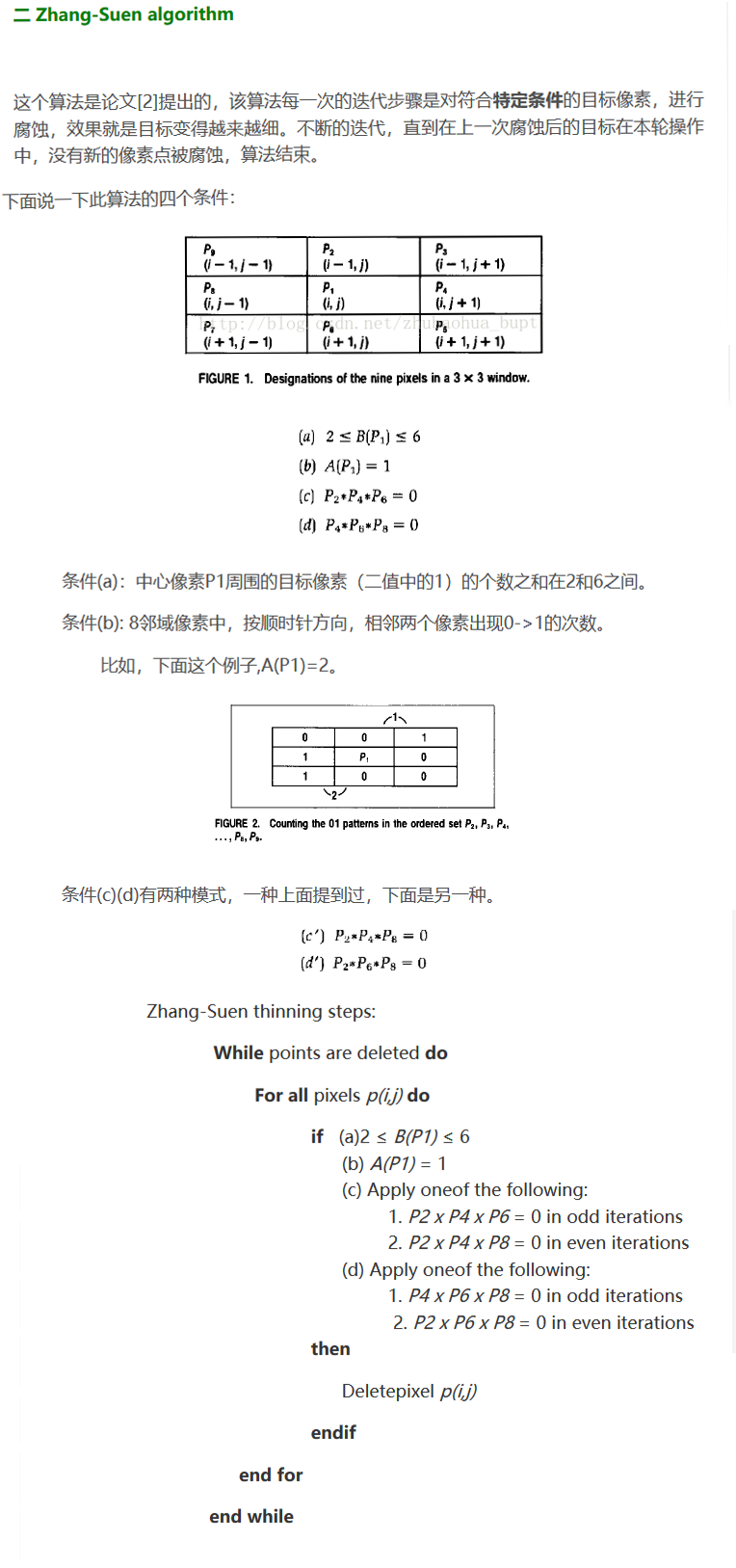记录一下图像骨架提取算法,转载至 两种图像骨架提取算法的研究(1)原理部分
基于OpenCV的实现代码如下,代码部分参考 opencv骨架提取/图像细化
void thinImage(Mat & srcImg) {
vector<Point> deleteList;
int neighbourhood[9];
int nl = srcImg.rows;
int nc = srcImg.cols;
bool inOddIterations = true;
while (true) {
for (int j = 1; j < (nl - 1); j++) {
uchar* data_last = srcImg.ptr<uchar>(j - 1);
uchar* data = srcImg.ptr<uchar>(j);
uchar* data_next = srcImg.ptr<uchar>(j + 1);
for (int i = 1; i < (nc - 1); i++) {
if (data[i] == 255) {
int whitePointCount = 0;
neighbourhood[0] = 1;
if (data_last[i] == 255) neighbourhood[1] = 1;
else neighbourhood[1] = 0;
if (data_last[i + 1] == 255) neighbourhood[2] = 1;
else neighbourhood[2] = 0;
if (data[i + 1] == 255) neighbourhood[3] = 1;
else neighbourhood[3] = 0;
if (data_next[i + 1] == 255) neighbourhood[4] = 1;
else neighbourhood[4] = 0;
if (data_next[i] == 255) neighbourhood[5] = 1;
else neighbourhood[5] = 0;
if (data_next[i - 1] == 255) neighbourhood[6] = 1;
else neighbourhood[6] = 0;
if (data[i - 1] == 255) neighbourhood[7] = 1;
else neighbourhood[7] = 0;
if (data_last[i - 1] == 255) neighbourhood[8] = 1;
else neighbourhood[8] = 0;
for (int k = 1; k < 9; k++) {
whitePointCount += neighbourhood[k];
}
if ((whitePointCount >= 2) && (whitePointCount <= 6)) {
int ap = 0;
if ((neighbourhood[1] == 0) && (neighbourhood[2] == 1)) ap++;
if ((neighbourhood[2] == 0) && (neighbourhood[3] == 1)) ap++;
if ((neighbourhood[3] == 0) && (neighbourhood[4] == 1)) ap++;
if ((neighbourhood[4] == 0) && (neighbourhood[5] == 1)) ap++;
if ((neighbourhood[5] == 0) && (neighbourhood[6] == 1)) ap++;
if ((neighbourhood[6] == 0) && (neighbourhood[7] == 1)) ap++;
if ((neighbourhood[7] == 0) && (neighbourhood[8] == 1)) ap++;
if ((neighbourhood[8] == 0) && (neighbourhood[1] == 1)) ap++;
if (ap == 1) {
if (inOddIterations && (neighbourhood[3] * neighbourhood[5] * neighbourhood[7] == 0)
&& (neighbourhood[1] * neighbourhood[3] * neighbourhood[5] == 0)) {
deleteList.push_back(Point(i, j));
}
else if (!inOddIterations && (neighbourhood[1] * neighbourhood[5] * neighbourhood[7] == 0)
&& (neighbourhood[1] * neighbourhood[3] * neighbourhood[7] == 0)) {
deleteList.push_back(Point(i, j));
}
}
}
}
}
}
if (deleteList.size() == 0)
break;
for (size_t i = 0; i < deleteList.size(); i++) {
Point tem;
tem = deleteList[i];
uchar* data = srcImg.ptr<uchar>(tem.y);
data[tem.x] = 0;
}
deleteList.clear();
inOddIterations = !inOddIterations;
}
}
原图和细化结果如下:


